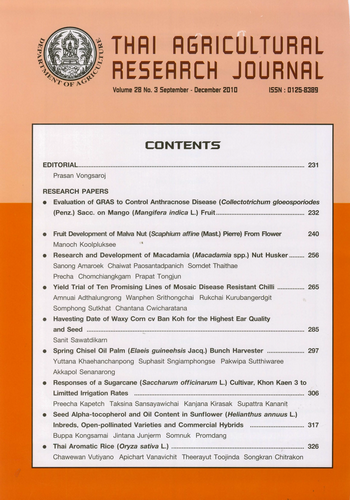Evaluation of GRAS to Control Anthracnose Disease (Collectotrichum gloeosporiodes (Penz.) Sacc. on Mango (Mangifera indica L.) Fruit
DOI:
https://doi.org/10.14456/thaidoa-agres.2010.25Keywords:
anthracnose, Colletotrichum gloeosporioides, control , generally recognized as safe (GRAS), mangoAbstract
Anthracnose disease caused by Colletorichum gloeosporioides is the major problem of mango (Mangifera indica) witch reduces both quality and shelf life. The experiments were carried out at the Post-harvest and Processing Research and Development Office, Department of Agriculture from October 2008-September 2009. This research was conducted to study the effectiveness of generally recognized as safe (GRAS, chemicals or substances added to food) with were propyl paraben, optiphen and salicylic acid at two concentrations namely 500 and 1000 mg/l to control mango anthracnose disease. The experimental design was CRD with 5 replications and 8 treatments: propyl, optiphen and salicylic acid at 500 and 1,000 mg/l compared to water control and imazaril at 500 mg/l. The results showed significantly different in percentage of mycelical inhibition. Propyl paraben at 500 and 1,000 mg/l had the efficacy to inhibit the mycelial growth of C. gloeosporioides by 100% which was similar to imazaril application at 500 mg/l. Salicylic acid and optiphen at 1,000 mg/l could inhibit the mycelia growth of this fungi by 71.26 and 50.66% respectively. The effective treatment to control anthracnose of inoculated mango fruits after keeping at room temperature for 7 day were salicylic acid 1,000 mg/l, salicylic acid 500 mg/l and optiphen 1,000 mg/l which had disease severity 6.35, 15.16 and 17.55% respectively. The disease severity of other treatments was not significantly different form control.
Downloads
Published
How to Cite
Issue
Section
License
Copyright (c) 2017 วารสารวิชาการเกษตร (Thai Agricultural Research Journal)

This work is licensed under a Creative Commons Attribution-NonCommercial-NoDerivatives 4.0 International License.
Thai Agricultural Research Journal



